A staple in Indian cuisine, Bajra Roti is a gluten-free flatbread made from finely ground Pearl Millet flour. These Instant Roti's need no leavening, just flour, water, and a little bit of practice. Here is mom's step-by-step recipe with all her tips and a video showing how to make perfect Bajra Roti at home.
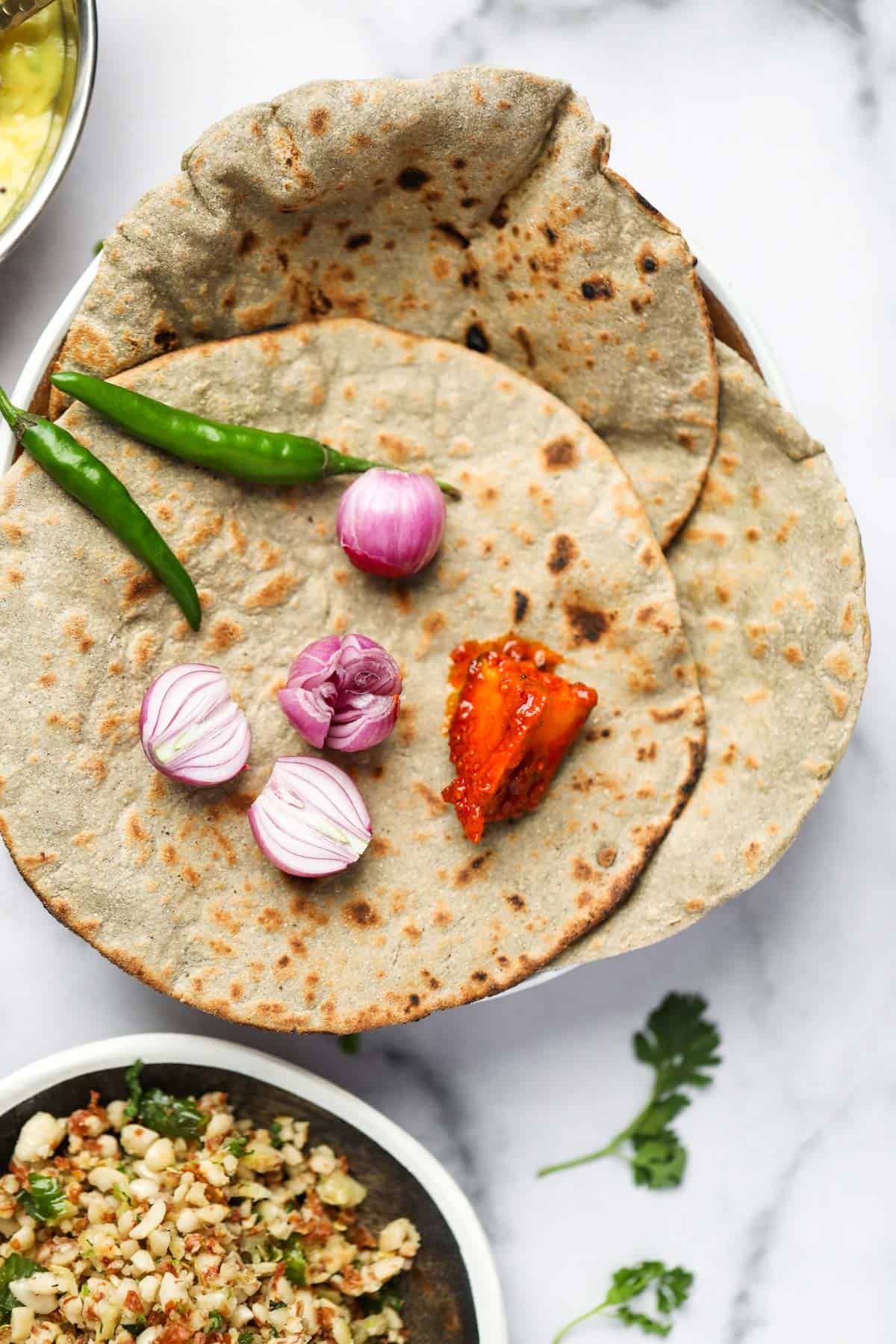
Jump to:
What is Bajra Roti
Bajra Roti also known as "Bajre ki Roti" (Hindi) or Bajri Chi Bhakri (Marathi) is an Indian flatbread made from finely ground pearl millet flour. Often served with Curries and Dal's Bajra Roti is especially popular in rural areas of Maharashtra, Gujrat, and Rajasthan. Unlike most rotis, Bajra roti has a dry-ish texture with a crispy top that makes it especially fun to eat especially with curried dishes like Patwadi Rassa.
Pearl Millet Health Benefits
- Naturally gluten-free
- Whole grain food
- Rich in vitamins, minerals, and amino acids
- Has a low glycemic index making it a good option for diabetics
- It may help in weight loss, and support healthy hair, nails, and skin
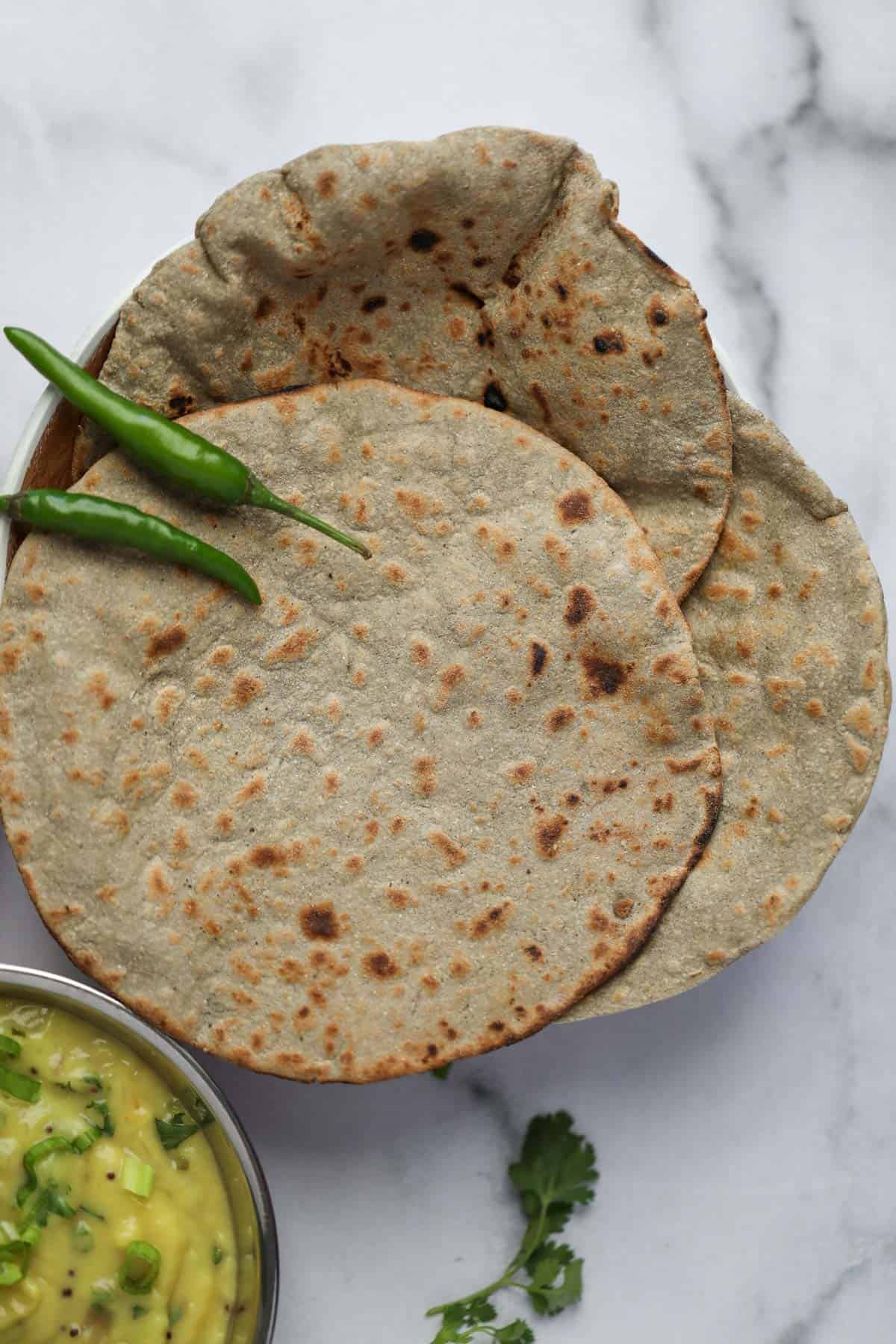
Ingredients
The only ingredient you need to make Bajra Roti is good quality, fresh, finely ground millet flour. In India, Bajra is usually milled every couple of weeks to get fresh flour. Here in the US, I recommend using Jalpur Brand Pearl Millet flour.

Tips to make perfect Bajra Roti
- Buy good quality, fresh Bajra flour. I highly recommend getting Jalpur brand bajri atta
- Bajri flour is best used within 2 weeks, to keep it fresh longer refrigerate or freeze the flour in an air-tight container.
- Knead the dough well, the dough will be nonsticky, soft, and pliable. Before making each roti, knead the dough ball well again for a minute.
- Liberally spread dry flour on the surface so the roti can be easily turned and moved around as you are pressing it.
- Make sure your hands are dry as you press the roti, and dip your fingers in dry flour if the dough starts to stick.
- Preheated the pan on medium heat before placing the roti.
- Spread the water evenly on the top surface to moisten any dry flour on top. This step helps prevent cracks on the roti and keeps it from getting dry
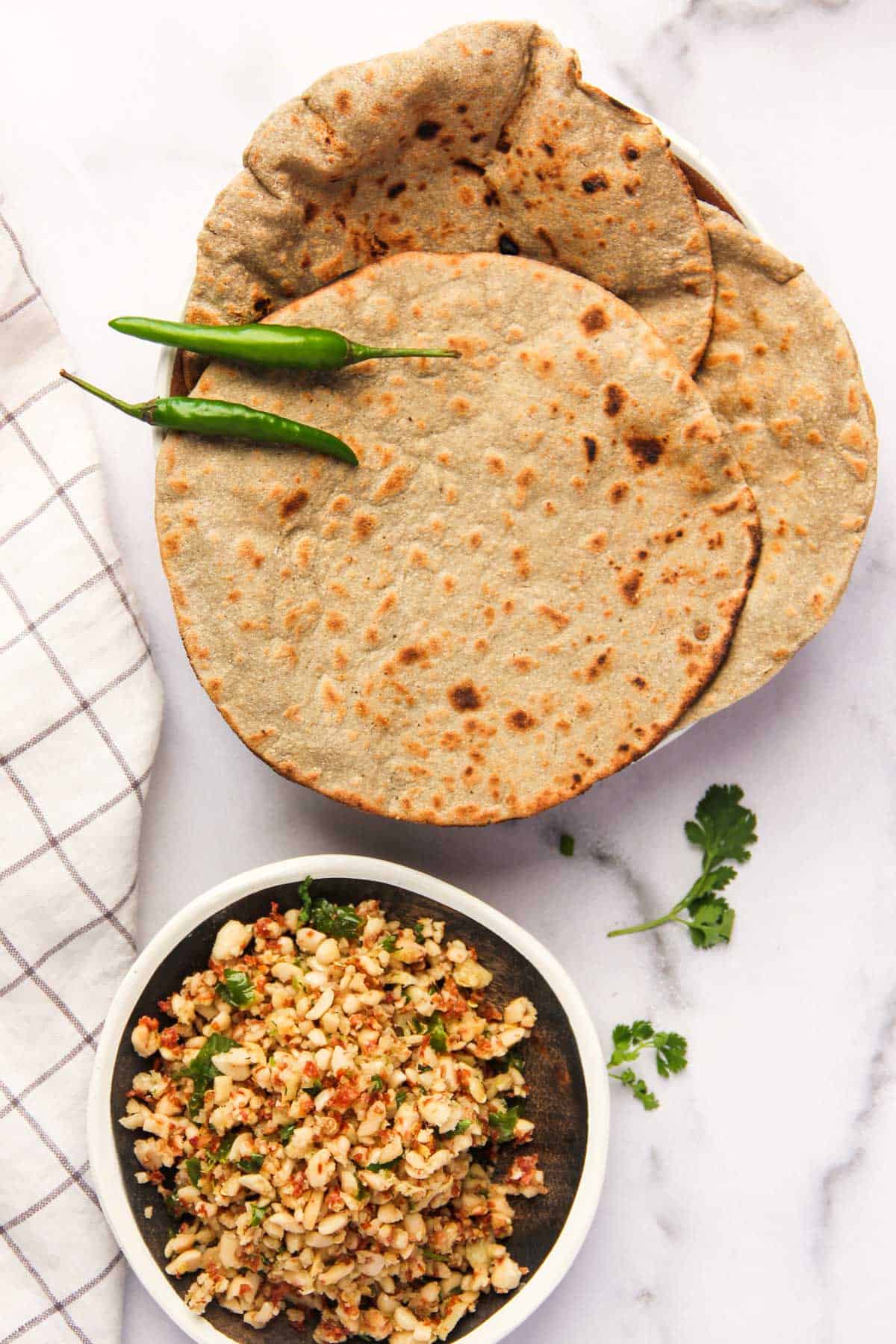
How to make Bajra Roti
- Add flour to a mixing bowl. Add water a little bit at a time and start kneading the dough. Add water as needed to make a soft yet pliable dough ball. Makes sure to knead it for 4 to 5 minutes for perfect Bhakri.
- Divide the dough into 3 balls.
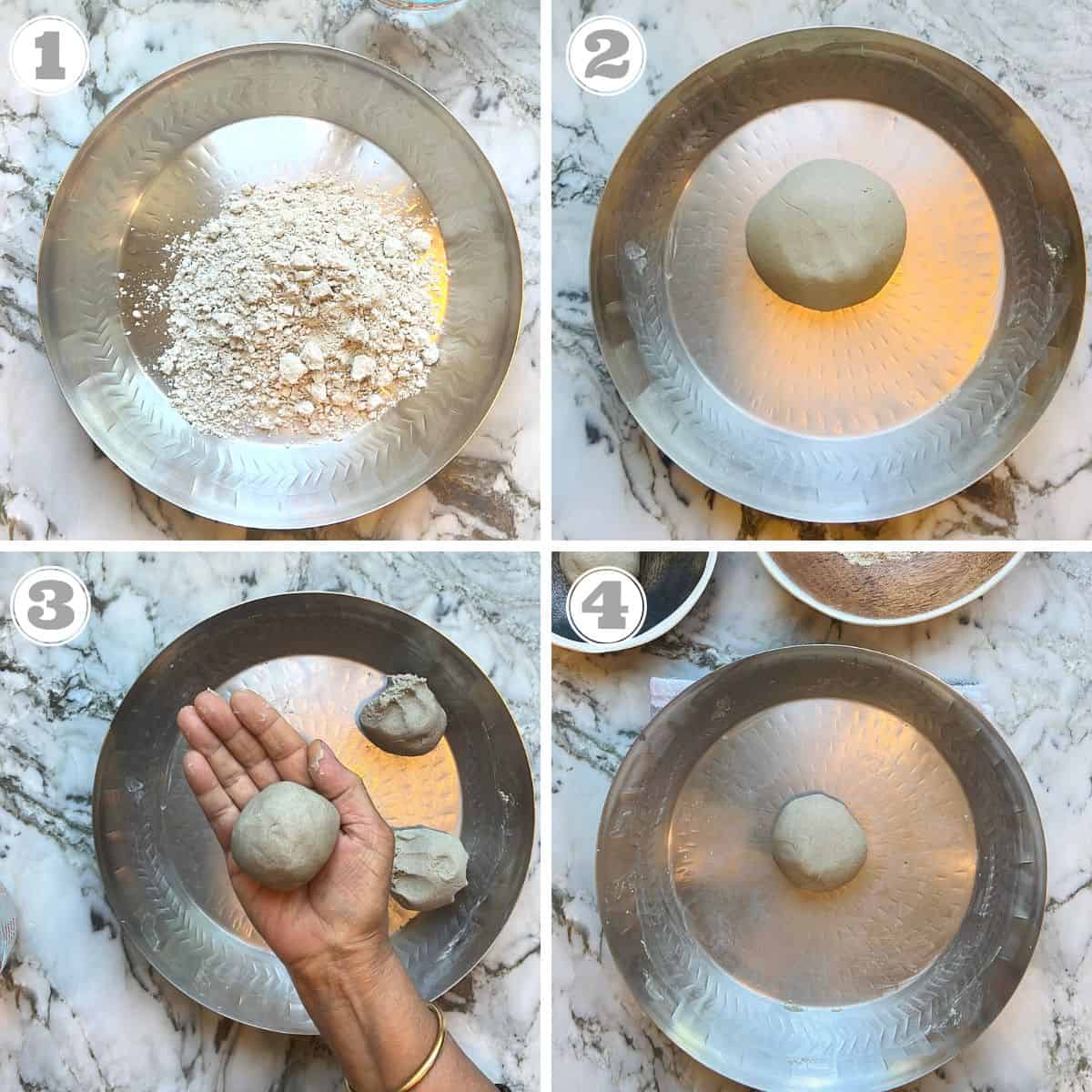
- Next, sprinkle 1 tablespoon of dry flour on a rolling surface and take the dough ball and gently flatten it using your hands to make a flat disc.
- Place the dough on the floured surface and start pressing the dough with the tip of your fingers and turning by a ten-degree angle. Continue pressing and turning as the roti becomes thinner and spreads about 6 to 8 inches. You can also try to press it down with 2 hands as shown by Mom in the photo.

- Carefully lift the roti and place it on a preheated pan with the flour side up. Lightly spread (or brush) one to two tablespoons of water on top of the roti keeping the pan on medium-high heat. The moisture on the roti will start to dry up in one to two minutes.
- Flip the roti using a flat spatula and cook the bottom side completely or until it gets light brown spots all over.
- Flip the roti again on the pan itself or on direct flame. If you are cooking on the pan, press down gently allowing the roti to fluff up. If cooking on a direct flame makes sure to rotate the roti so it cooks evenly. The roti is done when you see brown spots on the bottom side.

What to Serve With Bajra Roti
In Maharashtra, Pithla-Bhakri is a popular meal. "Pithla" is a spicy dish made with gram flour that pairs perfectly with these gluten-free Rotis. Bajra Rotis can be served with curries and dals alongside dry chutneys or pickles. Some of my favorite dishes to serve with these Bhakri are black-eyed peas curry, chicken curry, and spinach dal.
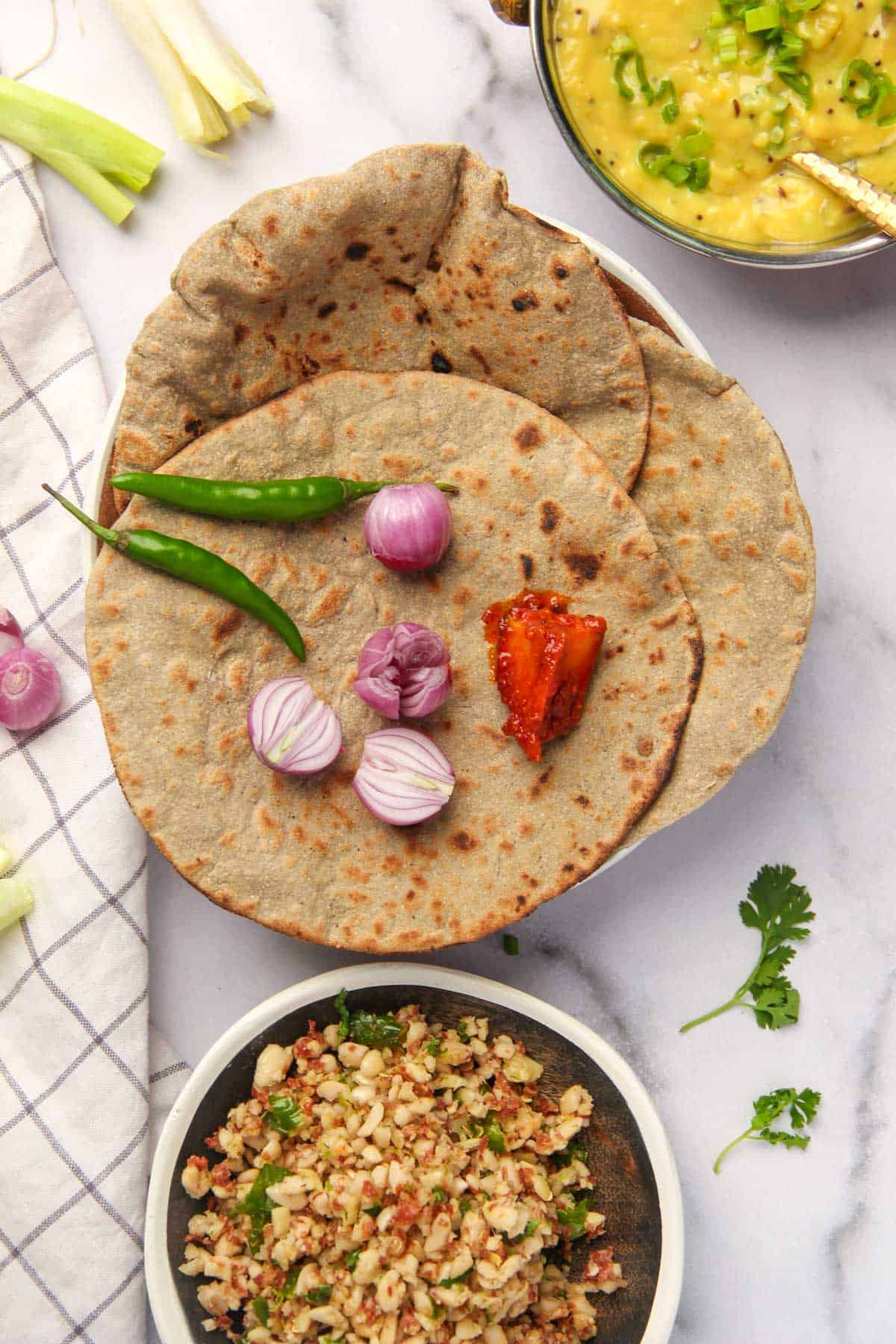
How to Store Bajra Roti
Freshly made Bajra Roti can be served hot, warm, or even at room temperature. Leftover Rotis can be refrigerated in an air-tight container for 2 to 3 days. To reheat, simply place the roti on a preheated pan and cook for 2 to 3 minutes.
More Gluten-Free Indian Bread Recipes
Here are some more Indian bread recipes made with whole wheat flour:
Recipe
Bajra Roti | Bajre Ki Roti
Ingredients
- 1 cup Bajra Atta pearl millet flour
- ½ cup water
- ¼ cup Bajra Atta for rolling
- ¼ cup water for cooking
Instructions
- Add flour to a mixing bowl. Add water a little bit at a time and start kneading the dough. Add water as needed to make a soft yet pliable dough ball. Makes sure to knead it for 4 to 5 minutes for perfect Bhakri.
- Divide the dough into 3 balls. Take one ball and knead it again for one to two minutes.
- Next spinkle 1 tablespoon of dry flour on a rolling surface and place the dough ball on the flour. Flatten the dough ball a bit to make a thick disc.
- Now start pressing the dough on top of the dry flour, evenly distributing weight as the dough starts to flatten.
- After its rolled 4 includes or so you can also try to press it down with 2 hands as shown by mom in the video.
- Continue pressing down and turning the roti sprinkling dry flour on the bottom if needed so the roti turns easily without sticking.
- Carefully lift the roti and then place it on a preheated pan with the flour side up. Lightly spread (or brush) one to two tablespoons of water on top of the bhakri keeping the pan on medium-high heat. The moisture on the roti will start to dry up in one to two minutes.
- Carefully flip the roti using a flat spatula and cook teh bottom side completely or until it get light brown spots all over.
- Flip the roti again on the pan itself or on direct flame.
- If you are cooking on the pan, press down gently allowing the roti to fluff up. If cooking on direct flame makes sure to rotate the roti so it cooks evenly. The roti is done when you see brown spots on the bottom side.
- Repeat steps for the remaining dough balls.
Video
Notes
- Buy good quality, fresh Bajra flour. I highly recommend getting Jalpur brand bajri atta
- Bajri atta is usually best used within 2 weeks, to keep it fresh longer refrigerate the atta in an air-tight container.
- Knead the dough well! The dough will be nonsticky, soft, and pliable.
- Before making each roti, knead the dough ball for another minute.
- Liberally spread dry flour on the surface so the roti can be easily turned and moved around as you are making it
- Make sure your hands are dry as you press the roti. Dip fingers in dry flour if the dough starts to stick
- The pan should be preheated before placing the roti. Make sure the pan is at medium (not high or low) heat when you place the roti.
- Spread the water evenly on the top surface to moisten any dry flour on top. This step also helps prevent cracks on the roti as well as keeps it from getting too dry


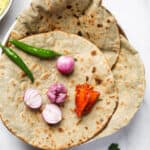
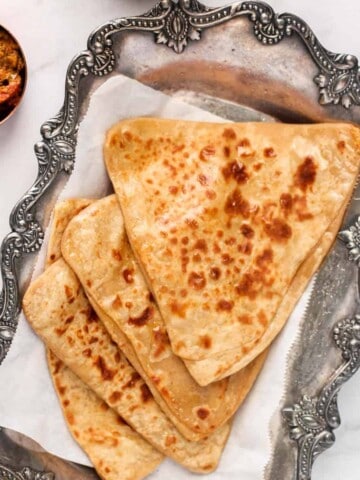
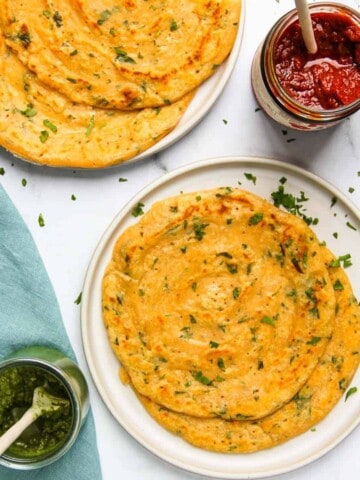


sonia says
Hi Archana, love all your posts and bajra roti is looking amazing. Shall try all these pro tips. Thanks for sharing.
Archana says
Can't wait for your feedback